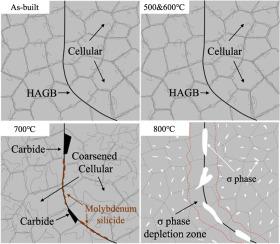Additive Manufacturing ( IF 10.3 ) Pub Date : 2021-04-02 , DOI: 10.1016/j.addma.2021.101981 Houshang Yin , Miao Song , Pu Deng , Lin Li , Barton C. Prorok , Xiaoyuan Lou

|
Thermal stability of the dislocation cellular structure and the precipitation behavior of chromium carbide (M23C6), silicide (Mo3Si), and σ phase in austenitic 316L stainless steel (SS) fabricated by laser powder bed fusion (L-PBF) additive manufacturing (AM) were studied at 500–800 ℃. The dislocation cellular structure and hardness remained stable at 500 ℃ and 600 ℃ for up to 400 h. However, the regional coarsening of cellular structure resulted in a slight reduction of hardness after 100 h aging at 700 ℃. Short-time thermal exposure (less than 0.5 h) at 800 ℃ destructed the cellular structure. Discontinuous coarse M23C6 carbide and semi-continuous fine molybdenum silicide precipitated along high angle grain boundaries (HAGBs), but not on the dislocation cellular boundaries at 700 ℃. A moderate Cr depletion of ~12.7 wt% was observed along HAGB. At 800 ℃, the σ phase precipitated both along the HAGBs and in the intragranular subgrain dislocation structures. Compared to the wrought 316L SS with and without cold work, AM 316L SS exhibited ten times faster nucleation and growth kinetics. The low-angle dislocation cellular structures and elemental segregation along these structures were found to accelerate σ phase precipitation. The growth of the σ phase precipitates in AM 316L SS was primarily controlled by particle growth at the early stage and particle coarsening (primarily through Ostwald ripening) at the later stage. Thermodynamic simulation suggested the Mo and Cr segregation along HAGBs in AM 316L facilitates σ phase formation, and higher GB Si activity in AM 316L SS is required to form Mo3Si.
中文翻译:

激光粉床熔融在500–800℃下增材制造的316L不锈钢的热稳定性和组织演变
激光粉末床熔合(L-PBF)在奥氏体316L不锈钢(SS)中位错胞结构的热稳定性和碳化铬(M 23 C 6),硅化物(Mo 3 Si)和σ相的沉淀行为在500–800℃下对增材制造(AM)进行了研究。位错的细胞结构和硬度在500℃和600℃保持稳定长达400 h。然而,在700℃时效100 h后,蜂窝状结构的局部粗化导致硬度略有降低。800℃的短时热暴露(小于0.5 h)破坏了细胞结构。不连续粗粒M 23 C 6碳化物和半连续细硅化钼沿高角度晶界(HAGBs)析出,但在700℃时不在位错晶界上析出。沿HAGB观察到适度的Cr损耗〜12.7 wt%。在800℃时,σ相沿HAGBs和颗粒内亚晶位错结构均析出。与有或没有冷加工的锻造316L SS相比,AM 316L SS的成核和生长动力学快十倍。发现低角度位错的细胞结构和沿这些结构的元素偏析会加速σ相的析出。AM 316L SS中σ相沉淀物的生长主要受早期阶段的颗粒生长和后期阶段的颗粒粗化(主要是通过奥斯特瓦尔德熟化)控制。3 Si。











































 京公网安备 11010802027423号
京公网安备 11010802027423号